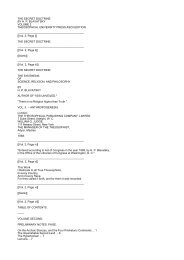Create successful ePaper yourself
Turn your PDF publications into a flip-book with our unique Google optimized e-Paper software.
Plates V. and VI.<br />
Sacred Texts Egypt Index Previous Next<br />
PLATES V. AND VI.<br />
Vignettes: The funereal procession to <strong>the</strong> tomb; running <strong>the</strong> length <strong>of</strong> <strong>the</strong> two plates. In <strong>the</strong> centre <strong>of</strong><br />
Plate V. <strong>the</strong> mummy <strong>of</strong> <strong>the</strong> dead man is seen lying in a chest or shrine mounted on a boat with runners,<br />
which is drawn by oxen. In <strong>the</strong> boat, at <strong>the</strong> head and foot <strong>of</strong> <strong>the</strong> mummy, are two small models <strong>of</strong><br />
Nephthys and Isis. By <strong>the</strong> side kneels Ani's wife Thuthu, lamenting. In front <strong>of</strong> <strong>the</strong> boat is <strong>the</strong> Sem priest<br />
burning incense in a censer,[3] and pouring out a libation from a vase; he wears his characteristic dress, a<br />
pan<strong>the</strong>r's skin. Eight mourners follow. one <strong>of</strong> whom has his hair whitened. In <strong>the</strong> rear a sepulchral ark or<br />
chest[4] surmounted. by a figure <strong>of</strong> Anubis and ornamented with emblems <strong>of</strong> "protection" and "stability,"<br />
is drawn on a sledge by four attendants, and is followed by two o<strong>the</strong>rs. By <strong>the</strong>ir side walk o<strong>the</strong>r<br />
attendants carrying Ani's palette, boxes, chair, couch, staff, etc.<br />
In Plate VI. <strong>the</strong> procession is continued up to <strong>the</strong> tomb. In <strong>the</strong> centre is a<br />
[1. "Thou goest forth over heaven in three-fold peace [in] thy sektet boat; when thou showest thy face . . . . . . . <strong>the</strong>e."<br />
2. "He giveth to <strong>the</strong>e thine eyes to see <strong>the</strong>rewith, and thine cars [to hear <strong>the</strong>rewith]."<br />
3. For a bronze censer similar in shape, see No. 5296 a, Fourth Egyptian Room.<br />
4. It is similar in shape to <strong>the</strong> chests which held <strong>the</strong> four jars containing <strong>the</strong> mummied intestines <strong>of</strong> <strong>the</strong> deceased. For<br />
examples <strong>of</strong> <strong>the</strong>m see Nos. 8543a, 8543b in <strong>the</strong> Third Egyptian Room.]<br />
{p. 264}<br />
group <strong>of</strong> wailing women, followed by attendants carrying on yokes boxes <strong>of</strong> flowers, vases <strong>of</strong> unguents,<br />
etc. In <strong>the</strong> right centre are a cow with her calf, chairs <strong>of</strong> painted wood with flowers upon <strong>the</strong>m, and an<br />
attendant with shaven head, carrying a haunch, newly cut, for <strong>the</strong> funereal feast. The group on <strong>the</strong> right is<br />
performing <strong>the</strong> last rites. Before <strong>the</strong> door <strong>of</strong> <strong>the</strong> tomb stands <strong>the</strong> mummy <strong>of</strong> Ani to receive <strong>the</strong> final<br />
honours; behind him, embracing him, stands Anubis, <strong>the</strong> god <strong>of</strong> <strong>the</strong> tomb; and at his feet, in front, kneels<br />
Thuthu to take a last farewell <strong>of</strong> her husband's body. Before a table <strong>of</strong> <strong>of</strong>ferings stand two priests: <strong>the</strong><br />
Sem priest, who wears a pan<strong>the</strong>r's skin, holding in his right hand a libation vase, and in his left a censer;<br />
and a priest holding in his right hand an instrument[1] with which he is about to touch <strong>the</strong> mouth and<br />
eyes <strong>of</strong> <strong>the</strong> mummy, and in his left <strong>the</strong> instrument for "opening <strong>the</strong> mouth."[2] Behind or beside <strong>the</strong>m on<br />
<strong>the</strong> ground, in a row, lie <strong>the</strong> instruments employed in <strong>the</strong> ceremony <strong>of</strong> "opening <strong>the</strong> mouth,"[2] etc., <strong>the</strong><br />
mesxet instrument, <strong>the</strong> sepulchral box, <strong>the</strong> boxes <strong>of</strong> purification, <strong>the</strong> bandlet, <strong>the</strong> libation vases, <strong>the</strong><br />
ostrich fea<strong>the</strong>r and <strong>the</strong> instruments called Seb-ur, Temanu or Tun-tet, and <strong>the</strong> Pesh-en-kef. The Kher-heb<br />
priest stands behind reading <strong>the</strong> service <strong>of</strong> <strong>the</strong> dead from a papyrus.<br />
Appendix: In <strong>the</strong> papyrus <strong>of</strong> Hunefer a slab or stele with rounded top is placed by <strong>the</strong> door <strong>of</strong> <strong>the</strong> tomb<br />
(Fig. 1, p. 265). In <strong>the</strong> upper part <strong>of</strong> it <strong>the</strong> deceased is shown adoring Osiris, and below is <strong>the</strong> legend,[3]<br />
"Hail, Osiris, <strong>the</strong> chief <strong>of</strong> Amenta, <strong>the</strong> lord <strong>of</strong> eternity,<br />
[1. This instrument is called ### ur hekau, and is made <strong>of</strong> a sinuous piece <strong>of</strong> wood, one end <strong>of</strong> which is in <strong>the</strong> form <strong>of</strong> a<br />
ram's head surmounted by a uræus (Fig. 1).<br />
http://www.sacred-texts.com/egy/ebod/ebod17.htm (1 <strong>of</strong> 12) [8/10/2001 11:26:43 AM]

















